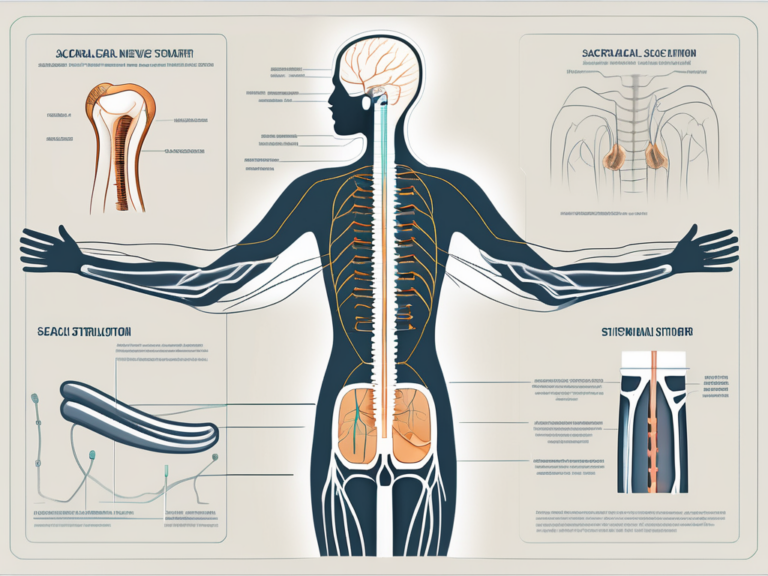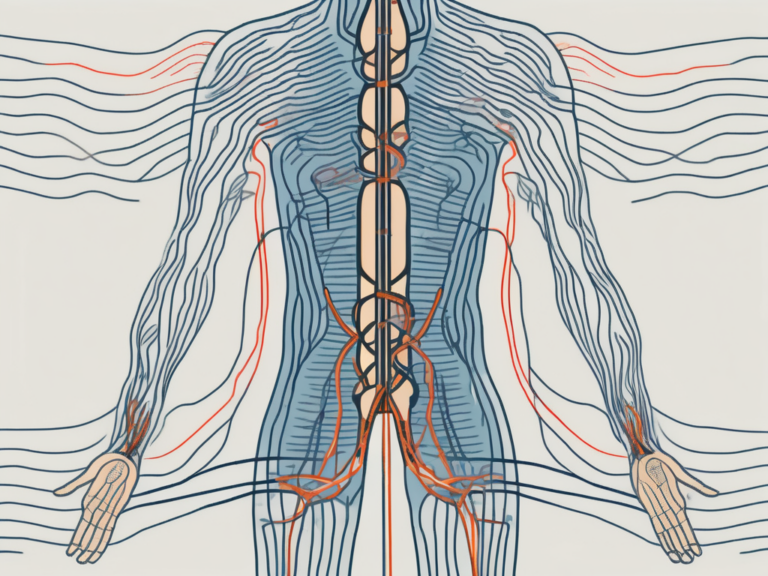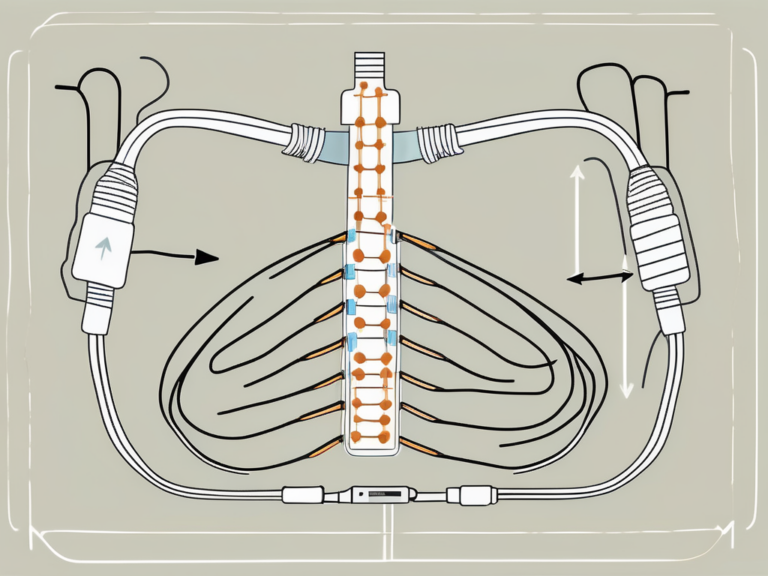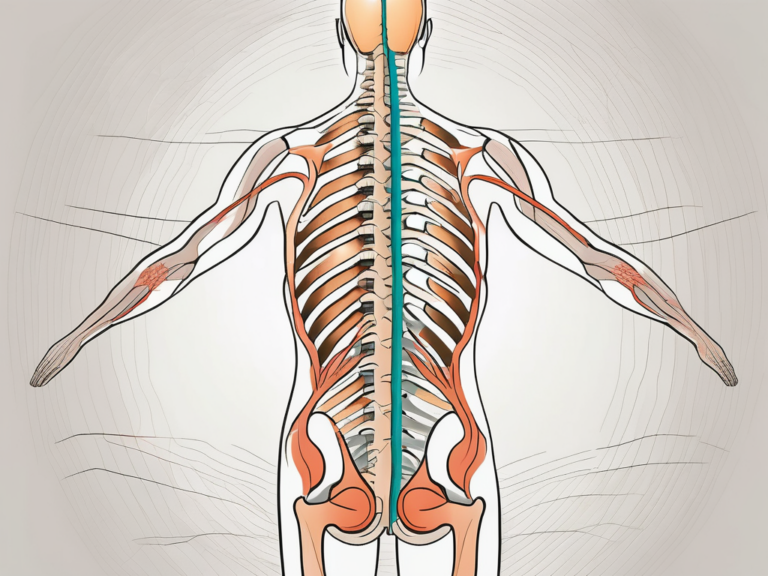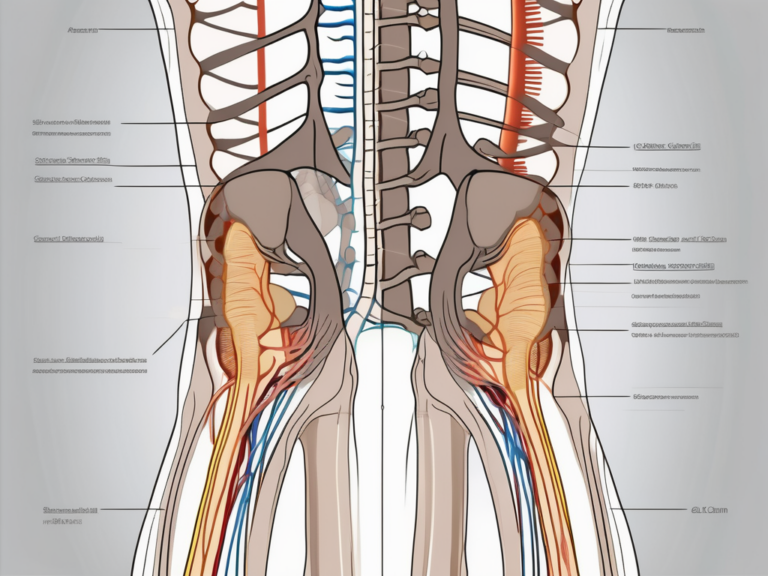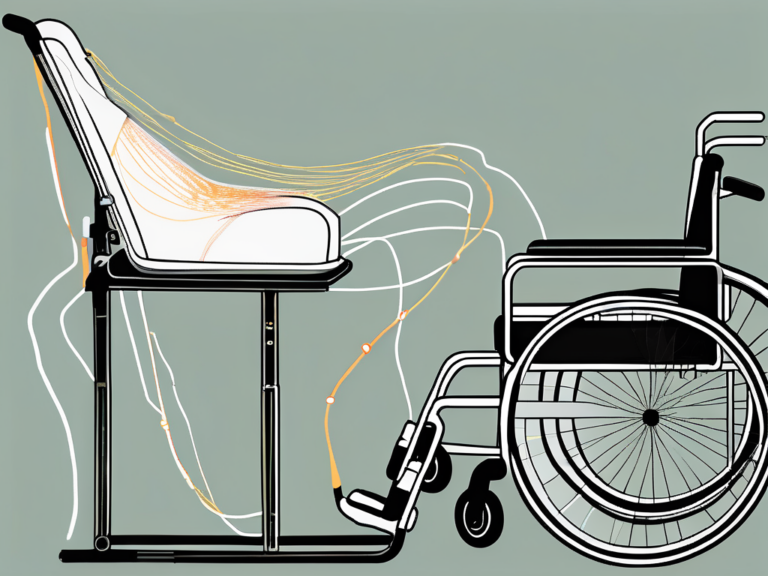Understanding the Role of the Anus Sphincter and Sacral Nerve
The anus sphincter and sacral nerve play crucial roles in the functioning of our bodies. While often overlooked, these structures are essential for maintaining bowel control and enabling normal bodily functions. In this article, we will take an in-depth look at the anatomy, functionality, and interplay between the anus sphincter and sacral nerve. We will also explore common disorders associated with these structures, available treatment options, and the future of research in this field.
Anatomy of the Anus Sphincter
The anus sphincter is a fascinating structure that plays a crucial role in our digestive system. Let’s dive deeper into its components and functionality to gain a better understanding of this remarkable muscular ring.
Components and Structure of the Anus Sphincter
The anus sphincter is composed of two main components: the internal and external sphincters. Each component has its own unique characteristics and functions.The internal sphincter, as the name suggests, resides within the walls of the anus. It is an involuntary muscle, meaning we have no conscious control over its contractions. This thick band of smooth muscle remains constricted at rest, only relaxing during the passage of stool. Its involuntary nature ensures that we don’t have to consciously think about controlling the release of feces.On the other hand, the external sphincter is a voluntary muscle that surrounds the internal sphincter. This skeletal muscle provides us with the ability to control defecation consciously. It is under the control of the somatic nervous system, allowing us to squeeze or relax the sphincter as needed. This voluntary control is what gives us the ability to hold in or release feces at will.
Functionality of the Anus Sphincter
The anus sphincter’s primary function is to maintain continence by keeping the anal canal closed when not evacuating waste. The coordinated action of both the internal and external sphincters prevents involuntary bowel movements and ensures fecal storage until defecation is initiated.When the rectum is filled with feces, the internal sphincter relaxes, allowing the stool to enter the anal canal. At this point, the external sphincter comes into play. Through conscious control, we can choose to either hold in the feces or initiate defecation by relaxing the external sphincter. This voluntary control is what allows us to delay defecation until it is convenient and appropriate.It’s important to note that the anus sphincter is not always tightly closed. It has a resting tone that keeps it partially contracted even when we’re not consciously controlling it. This resting tone helps maintain continence by providing a baseline level of closure, preventing any accidental leakage of feces.In addition to its role in continence, the anus sphincter also plays a part in sexual function. During sexual arousal, the muscles of the anus sphincter relax, allowing for comfortable penetration and pleasurable sensations.In conclusion, the anus sphincter is a complex and remarkable structure that ensures the controlled release of feces and maintains continence. Its internal and external components work together to provide both involuntary and voluntary control, allowing us to maintain bowel movements at our convenience. Understanding the anatomy and functionality of the anus sphincter helps us appreciate the intricacies of our digestive system.
The Sacral Nerve Explained
The sacral nerve, or sacral plexus, emerges from the lower part of the spinal cord and extends into the pelvis. It plays a vital role in transmitting signals between the brain and pelvic organs, including the anus sphincter.
The Location and Structure of the Sacral Nerve
The sacral nerve is located in the sacrum, which is the triangular bone at the base of the spine. It is formed by the fusion of several spinal nerves, including the fourth and fifth lumbar nerves and the first, second, third, and fourth sacral nerves. These nerves extend branching fibers to different muscles and organs in the pelvic region.
Within the sacrum, the sacral nerve forms a complex network of nerve fibers that innervate various structures. These fibers branch out to reach the muscles of the pelvic floor, such as the levator ani and coccygeus muscles. Additionally, the sacral nerve sends branches to the reproductive organs, including the uterus, vagina, and prostate gland in males.
The sacral nerve also connects to the bladder and rectum, allowing for coordinated control of these organs. It sends signals to the detrusor muscle in the bladder, enabling the contraction necessary for urination. Moreover, it innervates the external urethral sphincter, which helps in maintaining continence by keeping the urethra closed when not urinating.
The Role of the Sacral Nerve in Bodily Functions
The sacral nerve controls various bodily functions, such as bladder and bowel control, sexual function, and even leg movements. It carries signals from the brain to the anus sphincter, allowing us to consciously relax or contract the sphincter during defecation.
In addition to its role in defecation, the sacral nerve is also involved in sexual function. It plays a crucial role in the process of ejaculation in males and orgasm in both males and females. The nerve fibers within the sacral plexus transmit sensory information from the genitals to the brain, allowing for pleasurable sensations during sexual activity.
Furthermore, the sacral nerve contributes to the control of leg movements. It sends motor signals to the muscles of the lower limbs, allowing for coordinated movement and balance. Without the sacral nerve, our ability to walk, run, and perform various physical activities would be severely impaired.
Overall, the sacral nerve is a complex and essential component of our nervous system. Its intricate network of fibers enables the transmission of signals between the brain and pelvic organs, ensuring the proper functioning of bodily processes such as bladder control, sexual function, and leg movements.
The Interplay Between the Anus Sphincter and Sacral Nerve
The anus sphincter and sacral nerve work together in a complex interplay to maintain proper bowel control. The sacral nerve receives signals from the brain, relays them to the anus sphincter, and regulates its contractions.
How the Sacral Nerve Influences the Anus Sphincter
When the brain signals the need for defecation, the sacral nerve stimulates the external sphincter to relax, allowing the passage of feces. Simultaneously, the internal sphincter relaxes involuntarily due to the automatic signals from the sacral nerve.The sacral nerve plays a crucial role in coordinating the intricate dance between the anus sphincter and the brain. It acts as a messenger, transmitting signals from the brain to the anus sphincter, ensuring that the appropriate actions are taken at the right time. Without this communication, the process of defecation would be disrupted, leading to potential complications.The sacral nerve, located in the lower part of the spine, is part of the autonomic nervous system. It is responsible for controlling various bodily functions, including bowel movements. When the brain sends a signal indicating the need to empty the bowels, the sacral nerve springs into action, initiating a series of events that culminate in the relaxation of the anus sphincter.The external sphincter, which is under voluntary control, receives direct instructions from the sacral nerve. It relaxes in response to the signal, allowing the feces to pass through the anus. At the same time, the internal sphincter, which is not under conscious control, also relaxes due to the automatic signals from the sacral nerve.This synchronized relaxation of both sphincters is essential for the smooth and efficient elimination of waste from the body. The cooperation between the sacral nerve and the anus sphincter ensures that the process of defecation occurs without any hindrance.
The Impact of Anus Sphincter Function on Sacral Nerve Activity
On the other hand, dysfunction in the anus sphincter can have an impact on sacral nerve activity. For example, chronic conditions like anal fissures or hemorrhoids can cause pain and discomfort, leading to altered sacral nerve signaling and potentially affecting bowel control.When the anus sphincter is compromised, whether due to injury, inflammation, or other conditions, it can disrupt the normal functioning of the sacral nerve. The pain and discomfort associated with anal fissures or hemorrhoids can trigger abnormal nerve responses, leading to changes in the signals sent to the brain.In turn, these altered sacral nerve signals can affect bowel control. The coordination between the brain, sacral nerve, and anus sphincter may be disrupted, resulting in difficulties in regulating bowel movements. This can manifest as constipation, diarrhea, or even fecal incontinence, depending on the nature and severity of the dysfunction.It is important to address any issues with the anus sphincter promptly to avoid long-term complications. Seeking medical attention and following appropriate treatment plans can help restore the proper interplay between the anus sphincter and sacral nerve, ensuring optimal bowel control.In conclusion, the interplay between the anus sphincter and sacral nerve is a fascinating and intricate process. The sacral nerve acts as a messenger, relaying signals from the brain to the anus sphincter, while the anus sphincter responds accordingly to maintain proper bowel control. Dysfunction in the anus sphincter can disrupt sacral nerve activity, potentially leading to difficulties in regulating bowel movements. Understanding and addressing these interactions are crucial for maintaining optimal gastrointestinal health.
Disorders Related to the Anus Sphincter and Sacral Nerve
When it comes to the proper functioning of the anus sphincter and sacral nerve, there are several disorders that can cause significant problems. These disorders can lead to issues with bowel control and other related complications, affecting the overall quality of life for individuals who experience them.
Common Disorders of the Anus Sphincter
One of the most common disorders affecting the anus sphincter is fecal incontinence. This condition refers to the inability to control bowel movements, leading to involuntary leakage of stool. Fecal incontinence can be caused by various factors, including childbirth, trauma to the anal area, or underlying medical conditions such as inflammatory bowel disease.
Another disorder that can impair the proper functioning of the anus sphincter is anal fissures. These are small tears or cracks in the lining of the anus, often caused by passing hard or large stools. Anal fissures can be extremely painful and may cause bleeding during bowel movements.
Hemorrhoids are yet another common disorder that can affect the anus sphincter. These are swollen blood vessels in the rectum and anus, often caused by increased pressure in the area. Hemorrhoids can be internal or external and may cause symptoms such as itching, pain, and bleeding.
It is important to seek medical advice if you are experiencing persistent symptoms related to these disorders. A healthcare professional can provide an accurate diagnosis and recommend appropriate treatment options to alleviate symptoms and improve bowel control.
Sacral Nerve Dysfunction and Its Effects
The sacral nerve plays a crucial role in the proper functioning of the anus sphincter. When this nerve is dysfunctional, it can lead to a condition known as neurogenic bowel dysfunction. This dysfunction affects the ability of the anus sphincter to control bowel movements effectively, resulting in various complications.
Sacral nerve dysfunction can be caused by a range of factors, including spinal cord injuries, nerve compression, or diseases such as multiple sclerosis. In cases of spinal cord injuries, damage to the nerves in the lower back can disrupt the signals between the brain and the anus sphincter, leading to bowel control issues.
Nerve compression, often caused by conditions like herniated discs or spinal stenosis, can also affect the sacral nerve’s function. When the nerve is compressed or pinched, it can result in abnormal bowel movements and difficulties in controlling the release of stool.
Multiple sclerosis, a chronic autoimmune disease that affects the central nervous system, can also lead to sacral nerve dysfunction. The immune system mistakenly attacks the protective covering of nerve fibers, disrupting the normal transmission of signals between the brain and the anus sphincter.
If you suspect sacral nerve dysfunction, it is crucial to consult with a healthcare professional for an accurate diagnosis and appropriate management. Treatment options may include medications, physical therapy, or in severe cases, surgical intervention to alleviate symptoms and improve bowel control.
Treatment and Management of Anus Sphincter and Sacral Nerve Disorders
The treatment and management of anus sphincter and sacral nerve disorders depend on the underlying cause and severity of symptoms. It is imperative to consult with a healthcare professional for a proper diagnosis and individualized treatment plan.
Medical Interventions for Anus Sphincter Disorders
Medical interventions for anal sphincter disorders may include medications, such as topical creams or suppositories, to alleviate pain and inflammation. These medications work by reducing swelling and providing temporary relief. However, it is important to note that they do not address the root cause of the disorder.In some cases, more invasive measures may be required. Surgical procedures, such as sphincteroplasty, may be necessary to repair sphincter damage or remove obstructions. Sphincteroplasty is a surgical technique that aims to reconstruct the damaged anal sphincter, restoring its function and improving bowel control. This procedure is usually performed under general anesthesia and involves the careful reattachment of the torn or weakened muscles.
Therapeutic Approaches for Sacral Nerve Dysfunction
Therapeutic approaches for sacral nerve dysfunction focus on restoring the proper function of the sacral nerve and improving bowel control. One commonly used technique is pelvic floor muscle exercises, also known as Kegel exercises. These exercises target the muscles of the pelvic floor, including the sphincter muscles, and help to strengthen and tone them. By doing these exercises regularly, individuals can improve their ability to control bowel movements and reduce symptoms of sacral nerve dysfunction.Another therapeutic approach is biofeedback. Biofeedback is a technique that uses electronic sensors to monitor and provide feedback on muscle activity. In the case of sacral nerve dysfunction, biofeedback can be used to help individuals become more aware of their pelvic floor muscles and learn how to control them effectively. By receiving real-time feedback on muscle activity, individuals can learn to relax or contract their muscles as needed, improving their ability to control bowel movements.Electrical stimulation techniques may also be used in the management of sacral nerve dysfunction. This involves the use of low-level electrical currents to stimulate the nerves and muscles of the pelvic floor. The electrical stimulation can help to strengthen weak muscles, improve muscle coordination, and enhance nerve function. This technique is often used in combination with other therapeutic approaches to maximize the effectiveness of treatment.In conclusion, the treatment and management of anus sphincter and sacral nerve disorders involve a range of medical interventions and therapeutic approaches. It is crucial to consult with a healthcare professional to determine the most appropriate treatment plan for each individual. With proper diagnosis and personalized care, individuals can find relief from their symptoms and improve their quality of life.
The Future of Research in Anus Sphincter and Sacral Nerve Health
Ongoing research in anus sphincter and sacral nerve health is paving the way for potential breakthroughs in understanding and treating related disorders.
Emerging Trends in Anus Sphincter and Sacral Nerve Research
Researchers are exploring new techniques and technologies to better diagnose and manage anus sphincter and sacral nerve disorders. This includes advancements in neurostimulation, tissue engineering, and regenerative medicine.
Potential Breakthroughs in Treatment and Management
With further research, there is hope for developing novel treatment options and improving current therapeutic approaches. This may improve the quality of life for individuals affected by anus sphincter and sacral nerve disorders.In conclusion, understanding the role of the anus sphincter and sacral nerve is essential for recognizing the significance of these structures in maintaining bowel control and overall bodily function. Disorders related to these structures can have a significant impact on a person’s quality of life. Seeking medical guidance is crucial for accurate diagnosis, appropriate treatment, and timely management. Ongoing research in this field holds promise for improved understanding, diagnosis, and treatment options in the future.

